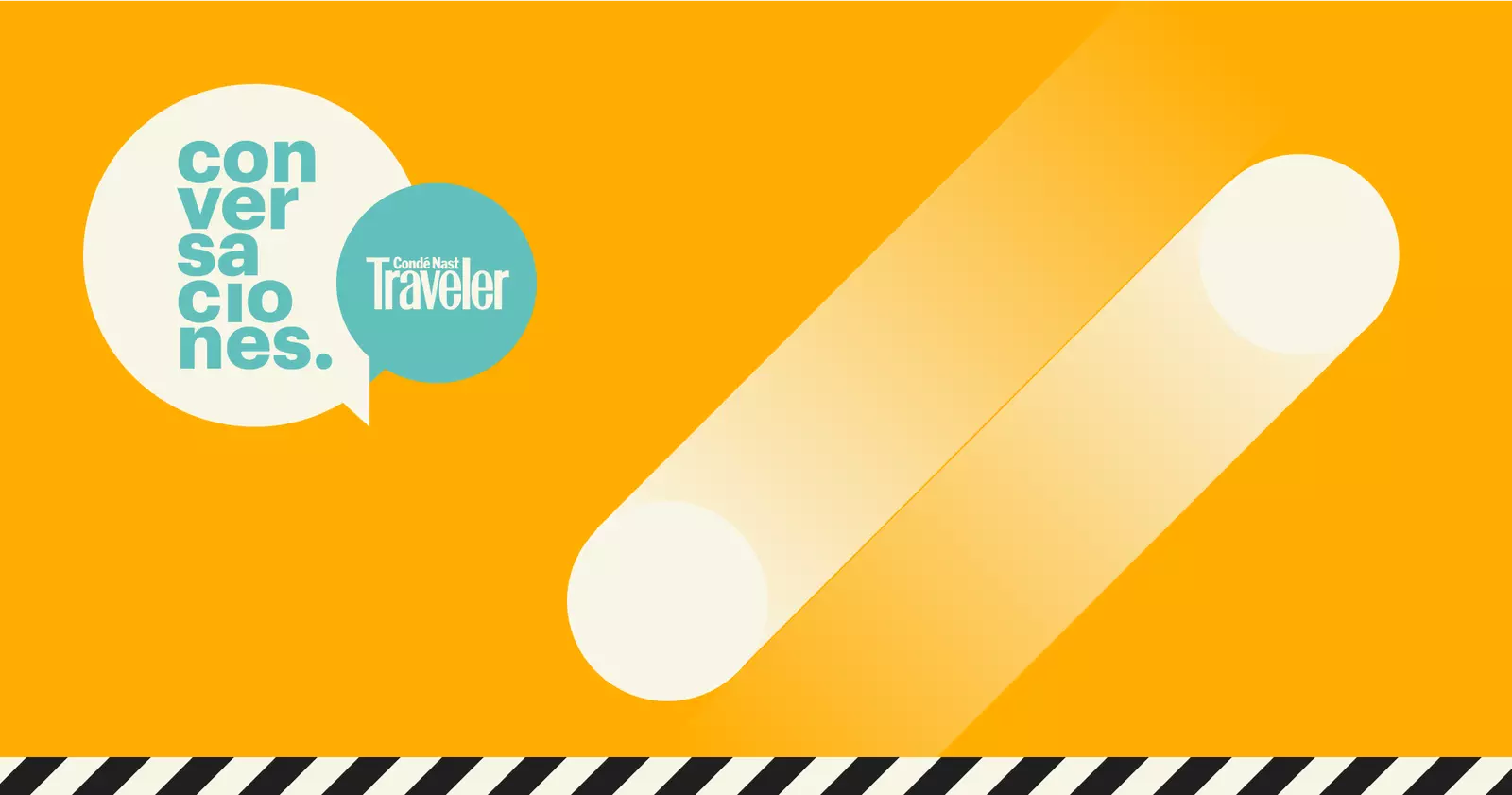
Condé Nast Traveler Conversations brings together industry experts to discuss the future of tourism
in these Condé Nast Traveler Conversations We have spent three days talking about what we know with those who know the most: travel and travelers . The health crisis has burst into our lives (and into the tourism sector) to mark a before and after. That is why in four days we tried to elucidate How will the future be what do the greats work on players of the sector now to be able to travel later.
So, on Monday, we struck up a conversation about Destinations answering the big questions: how, when and where will we travel again?; on Tuesday we face the hotels, future golden cages?; and today, we discuss the mobility challenges . Tomorrow you will be able to connect to know everything about the last block of trends : "Transforming trips, storytelling, communication tools and nostalgia as tools to learn successes from the past".
**ROAD TRIPS: IN SEARCH OF THE SPANISH ROUTE 66 **
"Road trips have always been in fashion, but this year they are the essence to once again trust in great trips." With these words of Miryam Tejada Segovia, communication executive of Escapada Rural, The first round table of the third day of Condé Nast Traveler Conversations began. moderated by María Fernández, editor-in-chief of traveler.es, they have participated in it Daniel Puertas, general business director of PANGEA The Travel Store, Alberto Gómez Borrero, traveler and adventurer, and the aforementioned Miryam Tejada Segovia, from Rural Escape.
They confirm what we already knew: **this summer the great trend is national tourism and that we have a crazy desire to travel, even if it is close. **
"This year, PANGEA The Travel Store has released a world map of Spain. All the places we dream of are close by", says the director of the travel agency. "Every time the government announced measures and openings, we saw how reserves grew," Miryam Tejada points out. "According to our surveys, 70% of travelers have told us that they want national rural tourism". And even Alberto Gómez Borrero, restless spirit and lover of remote and unexplored places for whom “If there is no signal, it is a good sign”, he acknowledges that, although he is looking forward to traveling to far away places, he knows that “ Spain can be tremendously exotic: the Camino de Santiago, the Geode of Pulpí, Atapuerca…. We have real gems to rediscover”.
And for that, nothing like a road trip. "Live the road, as if the road were just another destination," says Daniel Puertas. "The journey is the way and if you already know the way, why not find a new one."
To be non-invasive responsible travelers, our experts recommend carry in your suitcase a lot of common sense, tolerance, respect, education... "The most contagious thing is fear and all you have to do is follow some rules that, deep down, cost nothing," says the director of PANGEA The Travel Store. Miryam agrees: "If they tell you that you have to take your temperature before entering or take off your shoes, do it. Many of these destinations are fragile destinations, with little contact with the outside."
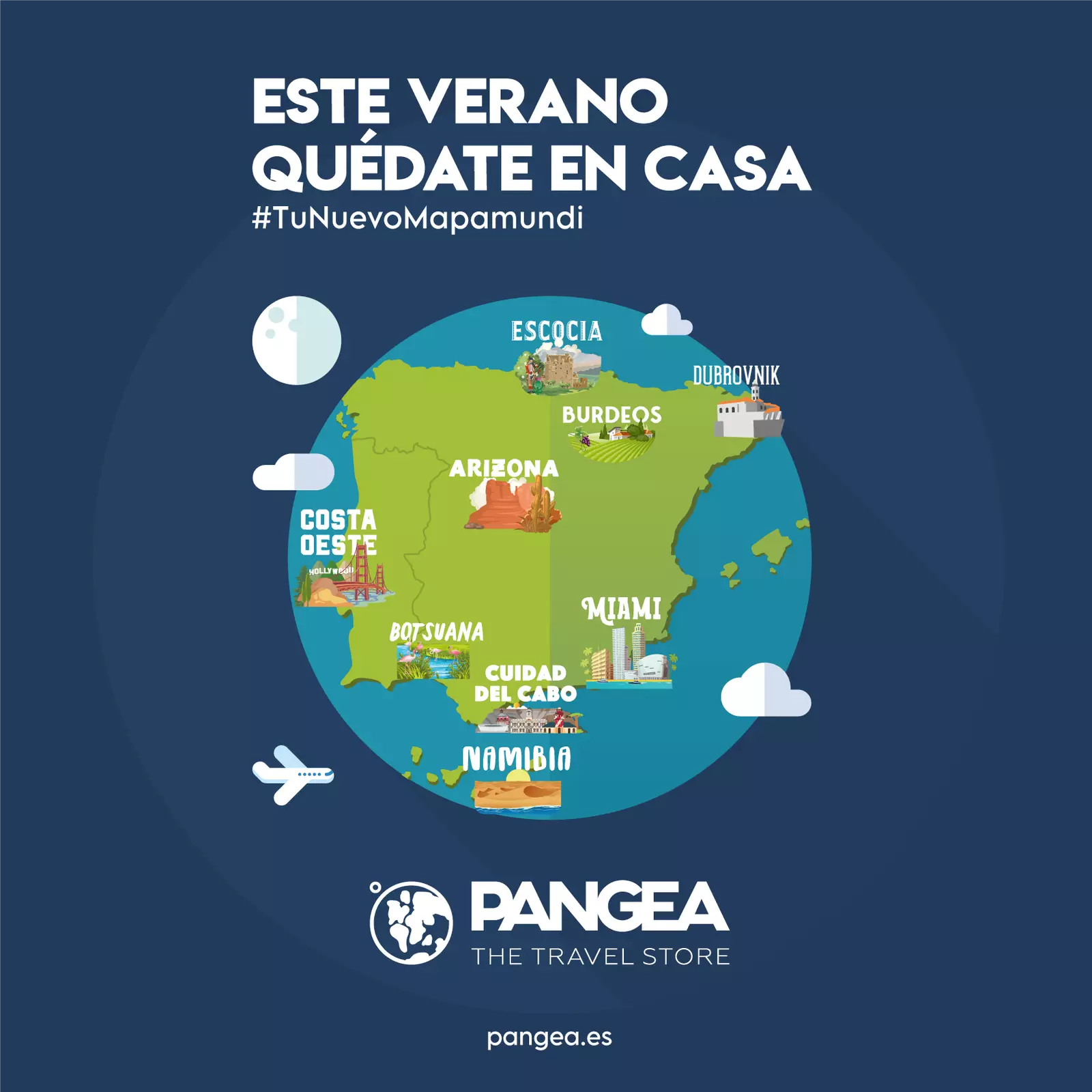
This summer stay home
For those looking for a "Route 66" in our country, the communication executive of Rural Escape, suggests the Cantabrian highway, "through natural landscapes, gastronomy, cultural and historical heritage", in addition to "the route through the Catalan Romanesque, the Silver Route, the black towns of Guadalajara...", while the director of PANGEA encourages slow travel , a travel slowly , and recommends “the contrast travel (in landscapes and in people), like the one that can be done following the A-6 motorway, our great Route 66, from Seville to Gijón” or, being more ambitious, “from Cadizfornia to Galifornia or, why not, make a return to Spain".
Alberto, for his part, prefers get your wheels stained with mud in the Transpirenaica or in the Picos de Europa, 4x4 routes, both of which are not too demanding, r ecotouring on the Cantabrian coast surfing, follow the Ruta de la Plata or “ getting lost on any secondary path” and he recommends "taking a bike to, if you want, to be able to make routes at each stop".
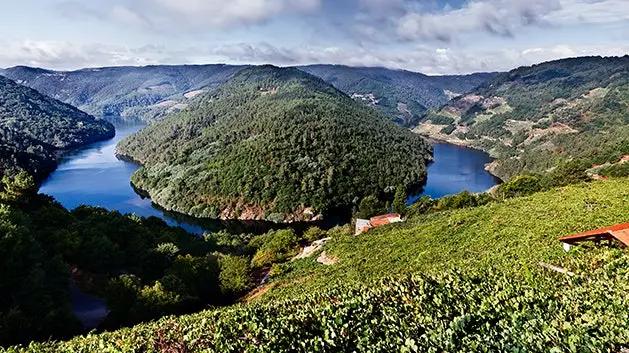
Mino river by Ribeira sacra.
TEN DAYS AT SEA. THE REINVENTION OF A HIGH PROFITABILITY MODEL
With the entire fleet of cruise ships anchored in port in recent months and a summer marked by cancellations, everyone considered the summer lost, but the sector is beginning to show signs of recovery. That's how it indicated Juan Rodero, CEO of StarClass, wholesaler specializing in boutique and high-end cruises: “We didn't expect it, but operations have returned much sooner than expected. As of July, cruises return to Europe and some river cruises (on rivers such as the Rhine, the Danube, the Duero or the Guadalquivir) have already restarted their activity. We are also starting to sell cruises to the Greek islands, to French Polynesia and some French companies are restarting their Corsica and Sardinia itineraries.”
With this good news began the second round table of the day, moderated by Quico Taronji , presenter of the Condé Nast Traveler Conversations and expert navigator, and in which they have participated, apart from director of Starclass, Pablo Ruibal, COO and founding partner of Boatjump Y Sento de Cecilio, an inveterate traveler that he is lucky enough to work on a private super yacht, “Caribbean in winter, Mediterranean in summer”, so that the sea is his life.
Pablo Ruibal has also been optimistic. His company Boatjump, "a kind of Booking.com for boats" whose mission is "to make renting a boat as simple as reserving a hotel room or renting a car", has seen how, in the last month, **" activity is picking up at a much faster rate than expected.” **The reason is obvious: social distancing. “With a maximum capacity of twelve people, traveling on one of our sailboats is an ideal formula for a vacation with family or friends, especially if you compare it with crowded beaches and overcrowded destinations”, he assures.
But to reach this situation of optimism, the sector has had to bring out all its creativity and adaptability. "Boatjump is aimed at the Spanish and North American markets, half-half, and looking for a way to reactivate the business this summer, we saw that the limitation was marked by the lack of flights, so we devised to make a "shuttle" between Denia and the Balearic Islands. Thus, you can go by car to Denia and from there jump on the boat without having to interact or mingle with anyone. The success is being incredible”, says Pablo Ruibal. “The charter sector is quite rigid, with departures and returns closed. However,** crises help make supply more flexible** and we see that, just like 20 years ago, apartments were only rented for fortnights and now they are rented for weeks or even days, right now Shipping companies are adapting their offer to customer demand. And this is a novelty that is here to stay, just like the “cabin charter” modality (rental of a cabin, as if it were a hotel room), thanks to which it is no longer necessary to rent the entire boat. It is about democratizing the possibility of enjoying the sea”.
This ability to reinvent themselves is also evident in the classic cruise market, as Rodero explains: "One of the most successful products right now is the cruises on the Guadalquivir. Traditionally these trips were geared towards foreigners, however this year we are selling it nationally. Other products in great demand by the Spanish traveler are the Douro river from Porto or the Canary Islands, visiting an island every day, It will start operating in October.
About boat safety, the director of Starclass remembers that “The protocols that we are becoming familiar with today were already a reality on cruise ships, where safety and health measures have always been extremely high.” But, in addition, Rodero continues: "A base protocol is going to be drawn up and, based on it, each shipping company will establish its measurements and mark the return, ship by ship . Small shipping companies, where it is much easier to work on social distancing, are already drafting their protocol and some will request a prior serological test or temperature measurement to be able to board.
The most popular and largest cruise ships do not yet have a return date. It is thought that it will be in autumn and prices, as always, will depend on demand. “Cruise passengers are very loyal travelers. The demand is there, latent, but many will not return until 2021”, concludes Rodero.
FLYING WILL NOT BE THE SAME, BUT IT MAY BE EVEN BETTER
How we will fly from now on is still not entirely clear, but that we will do it safely is one of the maxims of all the agents that make up the value chain of the aeronautical industry which, according to the latest studies, already start to take flight . In the third Condé Nast Traveler conversation of the day, Juan Gómez, Insights Expert at ForwardKeys, Daniel Lozano, Head of Compliance and Sustainability Control at Iberia Express, and María Teresa Busto, Vice President of Airbus and Director of Airbus in Illescas, moderated by Condé Nast Traveler contributor Lorena G. Diaz They have talked about recovery, about what it will be like to fly by plane from now on and, of course, about the destinations we want to travel to.
And no one better than ForwardKeys, a big data company that analyzes traveler flows globally, to tell us which destinations are sparking the most interest. "April and May have been empty months for reservations, but after the official announcements of the reopening of the borders, the volume of reservations made in Greece, Spain and Portugal indicates a clear recovery," explains Juan Gómez. But, Where do the Spaniards want to travel? “In May, the three most searched destinations were Italy, UK and USA, without looking at the departure date, and if we look at the most popular routes, for departures in July they are Madrid-Athens, Madrid-New York and Madrid-Reykjavik; and for departures in December, Madrid-New York, Barcelona-New York and Barcelona-Buenos Aires”. explains the ForwardKeys expert, who acknowledges that business travel will be the last to join this global recovery: “So far we haven't seen any kind of recovery in business travel, although in China, where the domestic market is very large, some ground has started to be recovered. Namely, the recovery will begin in domestic travel, followed by interregional and later, long-haul . It is something that we will see day by day because we go at different speeds depending on the destinations and markets of origin."
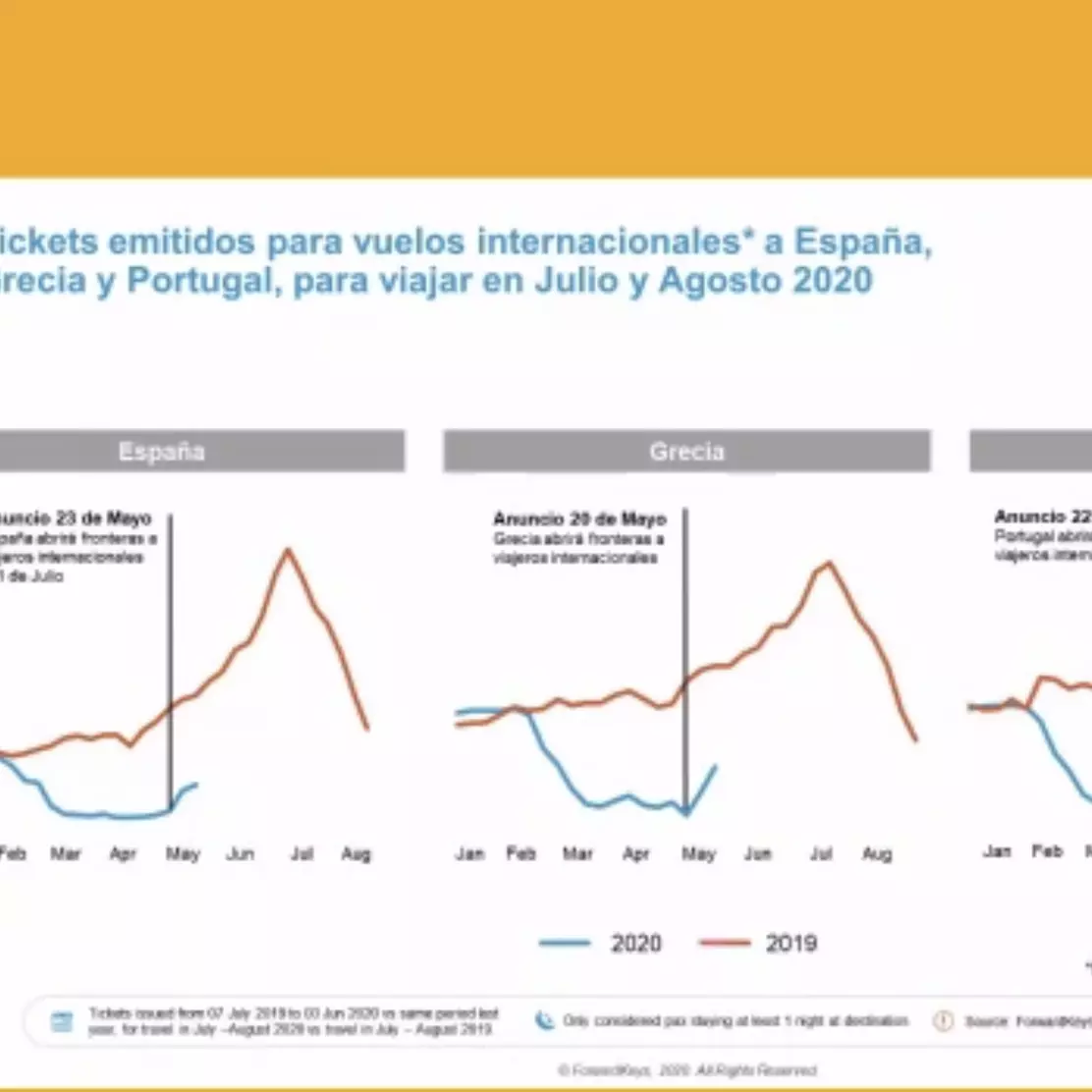
Data on airline tickets issued provided by ForwardKeys
The innovation that we are talking about so much lately is something that has already been implemented for many years in this sector. According to María Teresa Busto, director of Airbus in Illescas and inveterate traveler who has been to more than 150 countries: “Since 1994, Airbus has been using special HEPA filters, which are the ones used in certain areas of hospitals, with which particles are totally eliminated and air is transferred from outside to inside in a vertical way. That means that all particles smaller than 0.3 microns are eliminated (the COVID-19 particle is between 2 and 3 microns), what makes aircraft cabins totally safe places. This, accompanied by the usual security measures on planes and those we are implementing, makes us think that **it is not necessary to leave spaces between seats, so, yes, masks will have to be used throughout the journey”. **
And what will it be like to fly from now on? tell us Daniel Lozano, Responsible for Control of Compliance and Sustainability of Iberia Express: "Since mid-February we have been working to implement all the adapted protocols and procedures that were arriving little by little. What has already been published is a good practice guide, written in conjunction with the European Aviation Safety Agency (EASA) and the European Center for Disease Prevention and Control (ECDC), that cover the entire travel process (not just airlines). A) Yes, access to the airport, for example, will be exclusive to those who are going to travel. It is very important that the passenger knows and is aware of what is expected of them: queue management, mandatory masks from the moment they enter the airport, there will be a new boarding procedure, reinforced cleaning (with specific products) in the cabin and in areas of greater use in the airport. Passenger mobility will be limited, as will passenger interaction with the crew." This good practice guide will be adapted as the control of the pandemic progresses and it will be seen what will stay or not. We will keep reporting.
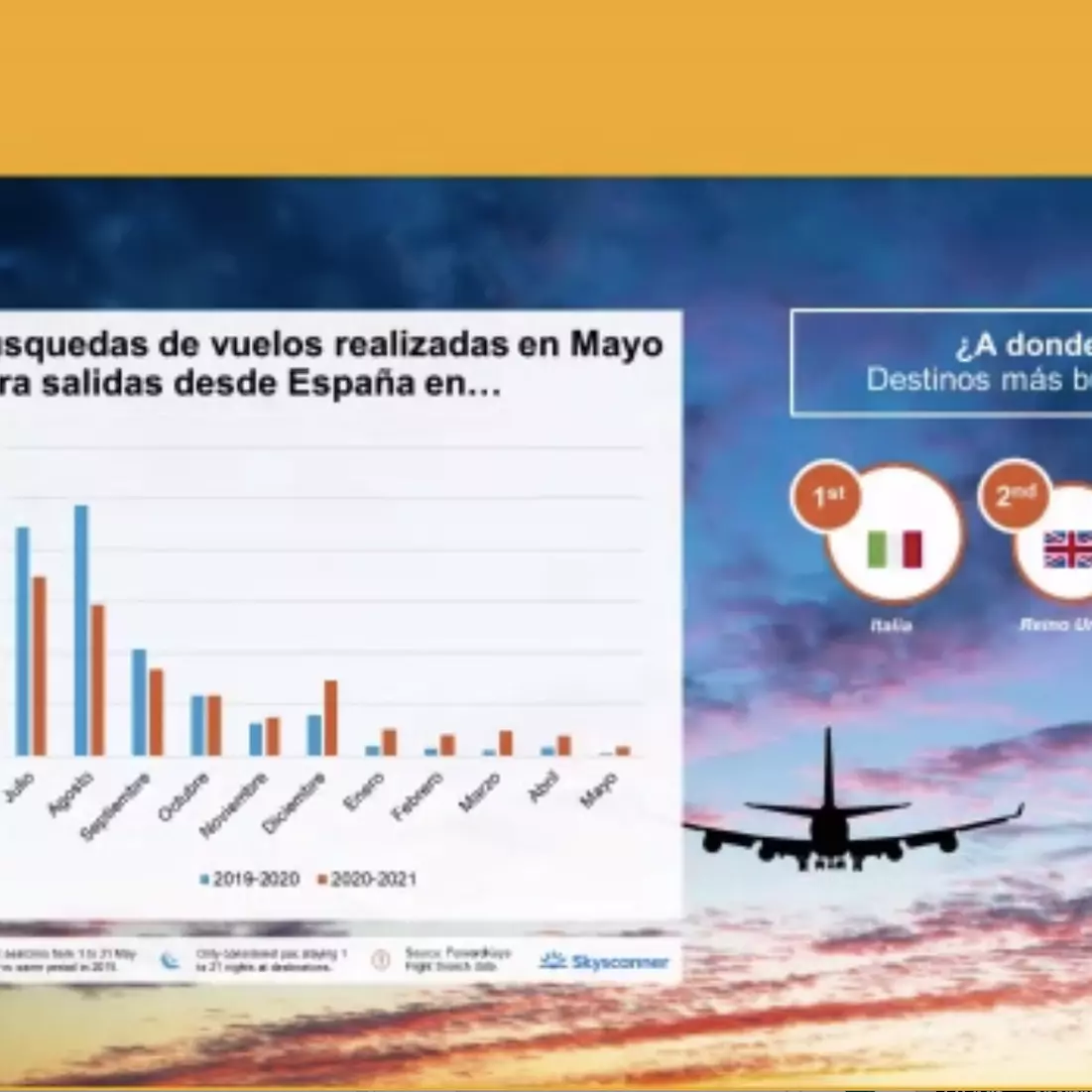
Graph provided by ForwardKeys on flight searches made from Spain
CITIES, EVEN SMARTER (AND FOR EVERYONE)
The so-called "intelligent destinations" and the data and technology applied to the service of citizens and visitors have been the protagonists of our last conversation of the day. moderated by Clara Laguna, Head of Fashion and Beauty at Condé Nast Traveler, Miguel Sanz, Director of the Madrid Destination Tourism Area of the Madrid City Council, Y Carlos González Luis, Grant Thornton Public Sector Consulting Partner and head of the CitizenLab project They have talked about the importance of the balance between visitors and residents and how to make tourism enrich the quality of citizens.
Miguel Sanz has focused on this point, who has explained the loyalty program of Madrid Destino: “Vuelve a Madrid works like any loyalty program, but without selling any product. The goal is to attract new visitors. With this, what we do is thank the people who come to Madrid (more than 10 million last year) and encourage them to come back. Because a traveler who returns to a destination participates in one of the virtues of tourism, which is the territorial and sectoral decentralization of spending. And this is generally good for the economic and distributive balance of the city and for its balanced development. Furthermore, this allows us a more personalized relationship with the traveler and offer them products that we know interest them more and thus travelers have a better experience”.
And it is that, as Miguel Sanz points out, the objective of tourism can be summed up in two very simple points and at the same time very difficult to achieve: "Improving the destination experience and that experience translates into quality of life for the resident. In other words, if those who visit Madrid consume a lot of culture, to give an example, the result for the people of Madrid will be more cultural offer".
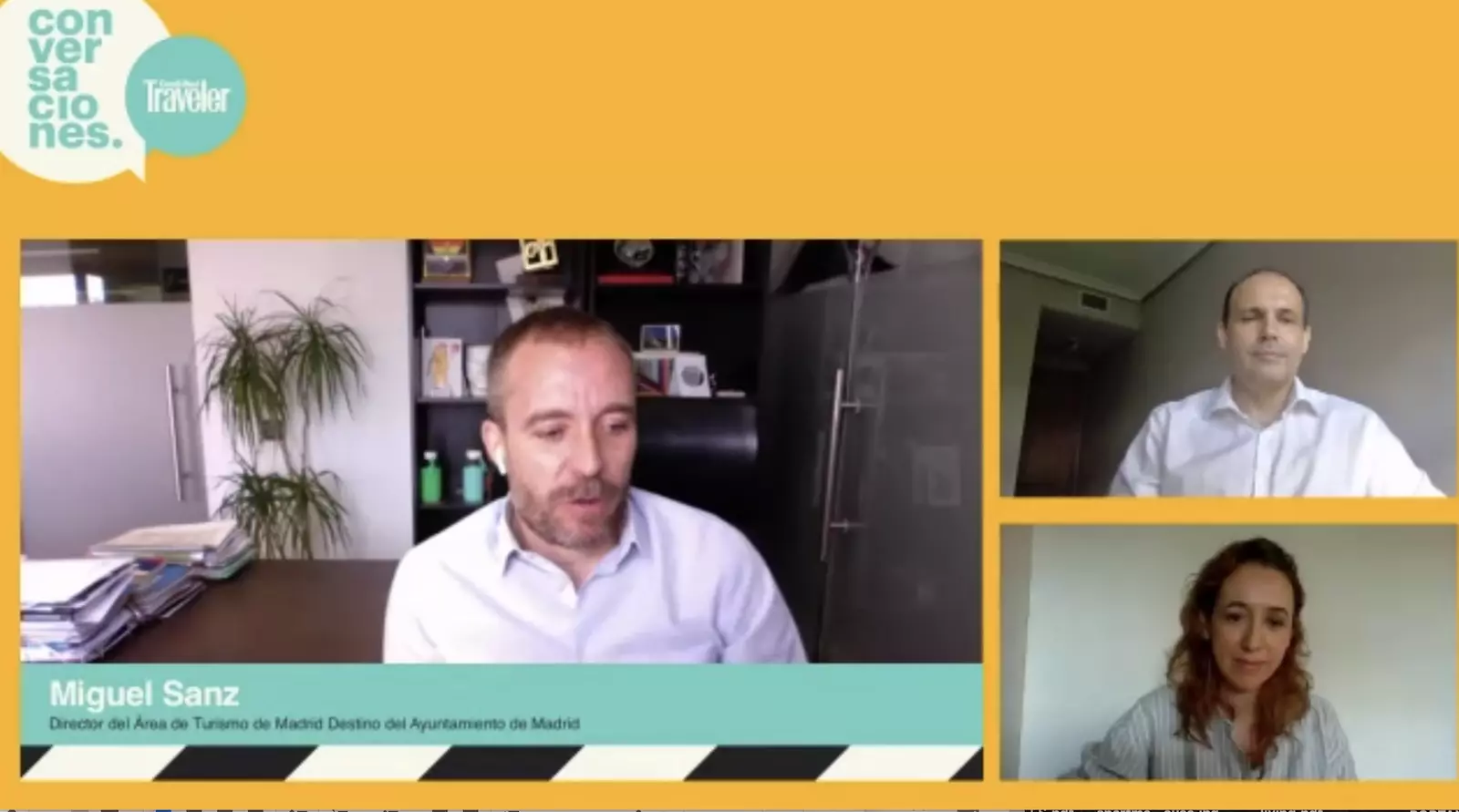
Moment of the conversation about Smart Cities
To help cities like Madrid to improve their offer, it is CitizenLab, “a project that analyzes the group behavior of tourists to create a large database from which we can extract descriptive analytics that tell us what is happening, how we can face plans for tomorrow”, explains Carlos González Luis. The objective is none other than to offer a higher quality destination. "Now the competition is fierce and we have to extract the best from each destination."
Many solutions emerge from data analysis . “For example, the decentralization of cities, return to the neighborhood models, recover places that we had forgotten, and offer proactive and personalized services in near real time. The result is a **unique experience that makes that tourist repeat or recommend. **What was previously decided by intuition or with outdated data, is now achieved with immediate data and that gives us a decision-making capacity that we did not have before”, comments the head of CitizenLab.
“Technology can tell us the imbalance between supply and demand. For example, a restaurant may want foreign tourists to arrive, but if it doesn't have its menu in other languages, it's more complicated, it has to adapt its product," says**** Miguel, who insists that “Tourism has to be a catalyst for the city model we want and provide added value to our city.”
